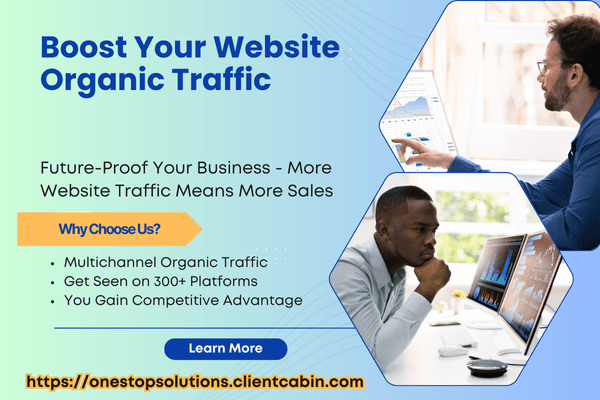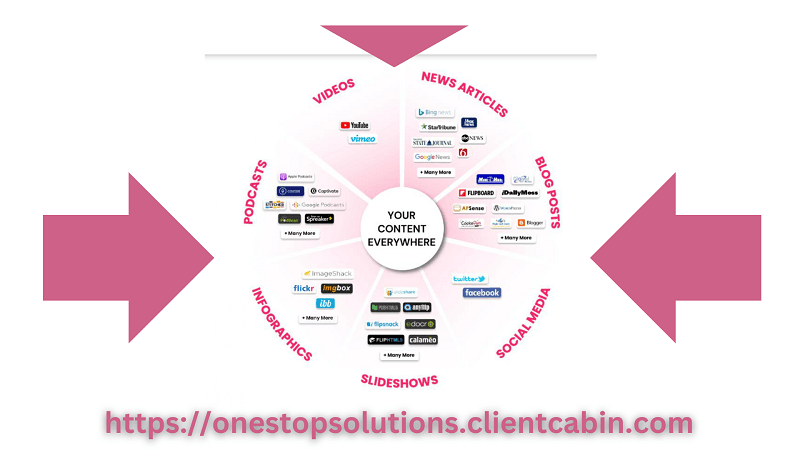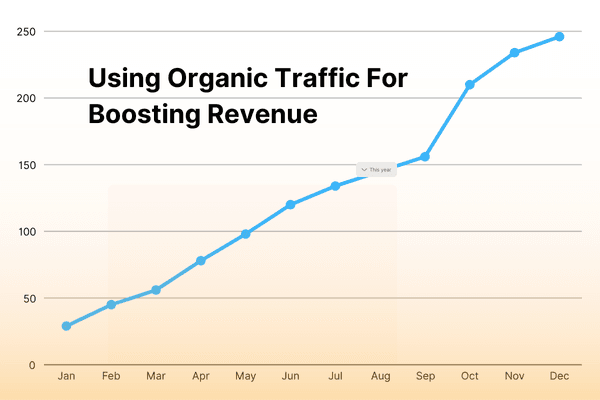Organic Traffic For Small Business is the Secret Weapon for Profitable Growth
Organic traffic refers to the visitors who land on your website from unpaid search results. Imagine having a steady stream of visitors to your website without spending a dime on advertising. That’s the magic of organic traffic for small business. It’s like planting seeds in a garden; with time and care, they grow into a flourishing ecosystem. For small businesses, this means more potential customers discovering your products or services naturally through search engines. Let’s dive into why organic traffic is essential for your business’s growth.
What is Organic Traffic?
When someone types a query into a search engine like Google, the results that appear are either paid ads or organic listings. These organic results are ranked based on relevance to the search term, which is determined by the search engine’s algorithm.
Unlike paid traffic, where you pay for each click, organic traffic is free if seen from an actual monetary outlay point of view . However, it requires effort to optimize your website so that it appears in these search results. The goal is to rank higher in search engine results pages (SERPs), making it easier for potential customers to find you and subtantially enhance your organic traffic for small business growth.
Benefits Over Paid Traffic
While paid traffic can deliver quick results, organic traffic offers several advantages that make it a powerful tool for small businesses. Firstly, it’s cost-effective. You don’t need a massive budget to start seeing results. Instead, you invest time and resources into creating valuable content and optimizing your website.
Moreover, organic traffic builds trust. Users are more likely to click on organic results because they see them as more credible than paid ads. This trust can lead to higher conversion rates and more loyal customers.
Cost-Effectiveness for Small Businesses
For small businesses, every dollar counts. That’s why organic traffic is a smart investment. It allows you to allocate resources towards creating high-quality content and improving your website’s SEO, rather than spending on expensive ad campaigns. Over time, this approach can yield significant returns, as your site climbs the ranks in search results and attracts more visitors.
Besides that, organic traffic offers sustainability. Once your site gains authority and ranks well, it can continue to attract visitors without ongoing costs. This long-term benefit makes it an attractive option for small businesses looking to grow steadily and sustainably.

Steps to Increase Organic Traffic for Your Website
Ready to boost your organic traffic? Here are some steps to get started. By following these strategies, you’ll be on your way to attracting more visitors and growing your business.
Optimize Your Website Content
Start by ensuring your website content is optimized for search engines. This means using relevant keywords throughout your site, from page titles and headings to meta descriptions and image alt tags. These keywords help search engines understand what your content is about and match it to users’ search queries.
Make sure your content is high-quality and provides value to your audience. Search engines prioritize content that answers users’ questions and solves their problems. Therefore, focus on creating informative, engaging, and well-structured content that keeps visitors on your site longer.
Utilize Long-Tail Keywords
Long-tail keywords are specific phrases that users are more likely to search for. They often have lower search volumes but higher conversion rates because they target users with clear intent. For example, instead of using a broad keyword like “shoes,” consider using a long-tail keyword like “comfortable running shoes for women.”
Using long-tail keywords can help your site rank for niche searches and attract more targeted traffic. Conduct keyword research to find the right long-tail keywords for your business, and incorporate them naturally into your content.
Enhance Mobile User Experience
With more people accessing the internet on their mobile devices, it’s crucial to ensure your website is mobile-friendly. A responsive design that adapts to different screen sizes can improve user experience and boost your site’s ranking in mobile search results.
Additionally, consider the speed and usability of your mobile site. Users expect fast loading times and easy navigation. Therefore, optimize images, minimize code, and ensure buttons and links are easy to click on smaller screens.
Improve Page Loading Speed
Page loading speed is a critical factor in both user experience and search engine ranking. Slow-loading pages can lead to high bounce rates, where users leave your site before it fully loads. This negatively impacts your site’s performance in search results.
To improve loading speed, compress images, enable browser caching, and reduce server response time. Use tools like Google PageSpeed Insights to identify areas for improvement and track your progress over time.
Use Video Content to Attract Audiences
Video content is a powerful tool to capture attention and convey information quickly. It’s engaging, easy to digest, and can significantly boost your organic reach. Create videos that showcase your products, share customer testimonials, or provide valuable tips related to your industry. These videos can be shared on platforms like YouTube, which is the second largest search engine, to reach a broader audience.
Promote Content on Social Media
Social media is a fantastic way to promote your content and drive organic traffic to your website. Share your blog posts, videos, and other content across platforms like Facebook, Instagram, and Twitter. Use captivating images and compelling captions to draw users in.
- Post regularly to keep your audience engaged.
- Use relevant hashtags to increase visibility.
- Engage with your followers by responding to comments and messages.
By actively promoting your content on social media, you can increase your reach and attract more visitors to your website.
The Role of SEO in Driving Organic Traffic
SEO, or Search Engine Optimization, is a crucial component of increasing organic traffic. It involves optimizing your website so that search engines can understand and rank it higher in search results. Let’s explore why SEO is vital for small businesses and how you can implement effective strategies.
Why SEO is Important for Small Businesses
- Increases visibility and exposure to potential customers.
- Builds credibility and trust with your audience.
- Offers a cost-effective way to drive traffic and generate leads.
SEO helps small businesses compete with larger companies by leveling the playing field. With the right strategies, even a small business can rank high in search results and attract a steady stream of organic traffic.
To succeed in SEO, focus on understanding your audience’s needs and creating content that addresses those needs. This customer-centric approach will naturally improve your site’s relevance and authority in the eyes of search engines.
On-Page SEO Strategies
On-page SEO involves optimizing individual pages on your website to improve their search engine rankings. This includes using relevant keywords, optimizing meta tags, and ensuring your content is easy to read and navigate.
Start by conducting keyword research to identify the terms your target audience is searching for. Use these keywords strategically throughout your content, but avoid keyword stuffing, as it can harm your rankings.
Off-Page SEO and Link Building
Off-page SEO refers to actions taken outside of your website to improve its ranking. Link building is a critical component, as it involves acquiring backlinks from other reputable sites. These backlinks signal to search engines that your site is credible and valuable.
- Reach out to industry influencers and bloggers to share your content.
- Guest post on relevant blogs to gain exposure and backlinks.
- Participate in online forums and communities to build relationships and earn links.
By building a strong network of backlinks, you can enhance your site’s authority and improve its position in search results.
Building a Community for Sustained Growth
Building a community around your brand can significantly impact your organic traffic and business growth. A loyal community not only engages with your content but also advocates for your brand, helping you reach new audiences.
Engage with Your Audience through Comments
Encourage your audience to leave comments on your blog posts and social media platforms. Respond to these comments promptly and thoughtfully to show that you value their input. This interaction fosters a sense of community and keeps users coming back for more.
Besides that, engaging with your audience through comments can provide valuable insights into their needs and preferences, allowing you to tailor your content accordingly.
Incorporate User-Generated Content
Example: A small coffee shop encouraged customers to share photos of their favorite drinks on Instagram using a branded hashtag. The shop then featured these photos on their website and social media, creating a sense of community and boosting organic engagement.
User-generated content (UGC) is a powerful way to build community and increase organic traffic. Encourage your customers to share their experiences with your brand and feature this content on your website and social media channels.
UGC not only provides fresh content for your site but also builds trust with potential customers, as they see real people enjoying your products or services.
Collaborate with Influencers
Partnering with influencers in your industry can help you reach new audiences and boost your organic traffic. Influencers have established credibility and a loyal following, making them valuable allies in promoting your brand. For more insights on leveraging influencer partnerships, check out this article on organic marketing as a secret weapon to driving conversions.
When choosing influencers to collaborate with, ensure they align with your brand values and have an audience that matches your target market. This alignment will lead to more authentic and effective partnerships.
Monitoring and Analyzing Your Organic Traffic
To ensure your organic traffic strategies are effective, it’s essential to monitor and analyze your results. This data-driven approach allows you to make informed decisions and optimize your efforts for better outcomes.
Use Google Analytics for Traffic Insights
Google Analytics is a powerful tool for tracking your website’s performance. It provides valuable insights into your organic traffic, including where it’s coming from, which pages are most popular, and how users interact with your site.
By analyzing this data, you can identify trends and patterns that inform your strategy. For example, if you notice a particular blog post is attracting a lot of traffic, consider creating similar content to replicate its success.
- Set up goals to track conversions and measure success.
- Use behavior reports to understand how users navigate your site.
- Monitor bounce rates to identify areas for improvement.
Regularly reviewing your analytics data helps you stay on top of your organic traffic performance and make necessary adjustments to achieve your business goals.
Understand User Behavior Patterns
Understanding how users interact with your website is key to optimizing for organic traffic. By analyzing user behavior patterns, you can identify what is working and what needs improvement. For instance, observe which pages users spend the most time on and which ones they leave quickly. This data can reveal valuable insights into the content and design elements that engage your audience.
Additionally, track the journey users take through your site. Are they following a logical path to conversion, or are they getting lost along the way? Use tools like heatmaps and session recordings to visualize user interactions and make informed adjustments to your site’s layout and navigation.
Adjust Strategies Based on Analytics Data
Once you’ve gathered data on user behavior, it’s time to adjust your strategies accordingly. If a particular page has a high bounce rate, consider revising its content or design to better meet user expectations. On the other hand, if a page is performing well, analyze what makes it successful and apply those elements to other areas of your site.
Regularly review your analytics data to identify trends and patterns. This ongoing analysis allows you to stay agile and responsive to changes in user behavior and search engine algorithms. By continuously refining your strategies based on data, you can ensure your organic traffic efforts remain effective and aligned with your business goals.
The Future of Organic Traffic For Small Business Growth Strategies
The digital landscape is constantly evolving, and staying ahead of the curve is crucial for sustained organic growth. As search engine algorithms become more sophisticated, businesses must adapt their strategies to maintain visibility and relevance. Let’s explore some key trends shaping the future of organic growth strategies.
Adapting to Search Engine Algorithm Changes
Search engines frequently update their algorithms to improve the quality and relevance of search results. These changes can impact your site’s ranking, so it’s essential to stay informed and adapt your strategies accordingly. Follow industry news and updates from major search engines like Google to anticipate algorithm changes and adjust your SEO tactics proactively.
Focus on creating high-quality, user-focused content that aligns with search engines’ evolving criteria. This approach will help you maintain and improve your site’s ranking, even as algorithms change.
Incorporating AI in SEO Tactics
Artificial intelligence (AI) is revolutionizing the way businesses approach SEO. AI-powered tools can analyze vast amounts of data to identify trends, optimize content, and improve user experience. By leveraging AI in your SEO tactics, you can gain a competitive edge and enhance your organic traffic efforts.
Example: A small online retailer used AI to analyze customer reviews and identify common keywords and phrases. This data informed their content strategy, resulting in more targeted and relevant blog posts that boosted organic traffic.
Embrace AI technology to streamline your SEO processes and gain deeper insights into your audience’s needs and preferences. This forward-thinking approach will position your business for success in the digital age.
Embracing New Content Formats
As user preferences evolve, so too must your content strategy. Explore new content formats, such as interactive quizzes, podcasts, and augmented reality experiences, to engage your audience in innovative ways. These formats can capture attention and drive organic traffic by offering unique and memorable experiences.
Experiment with different content types to see what resonates with your audience. By staying open to new possibilities, you can keep your content fresh and relevant, attracting more visitors and boosting your organic reach.
Frequently Asked Questions On Organic Traffic For Small Business
Here are some common questions small business owners have about increasing organic traffic. These answers will help you navigate the complexities of organic growth strategies.
How long does it take to see results from organic traffic strategies?
- Results can vary, but it typically takes 3-6 months to see significant improvements.
- Patience and consistency are key to achieving long-term success.
- Regularly monitor your progress and adjust strategies as needed.
Remember, organic growth is a gradual process. Stay committed to your strategies, and you’ll reap the rewards over time.
What is the difference between organic traffic and direct traffic?
Organic traffic comes from search engines like Google, while direct traffic refers to visitors who enter your website URL directly into their browser. Direct traffic often consists of returning visitors or those who have bookmarked your site. Both types of traffic are valuable, but organic traffic offers greater potential for reaching new audiences.
How do I find the right keywords for my small business?
Conduct keyword research using tools like Google Keyword Planner or SEMrush to identify relevant keywords for your industry. Focus on long-tail keywords that reflect your audience’s specific needs and preferences. Analyze your competitors’ keywords to uncover opportunities for differentiation and growth.
Is it possible to rely solely on organic traffic for business growth?
While organic traffic is a powerful driver of growth, it’s essential to diversify your marketing efforts. Complement your organic strategies with other channels like social media, email marketing, and paid advertising for a well-rounded approach. This diversification will help you reach a broader audience and achieve sustainable growth.
Consider organic traffic as the foundation of your marketing strategy, with other channels supporting and amplifying your efforts.
What are some common mistakes to avoid when increasing organic traffic?
Avoid keyword stuffing, as it can harm your rankings and user experience. Instead, focus on creating high-quality, relevant content that naturally incorporates keywords. Additionally, ensure your website is mobile-friendly and fast-loading to provide a seamless user experience.
Finally, don’t neglect the importance of link building and social media promotion. These elements play a crucial role in driving organic traffic and enhancing your site’s authority.
Key Insights on Organic Traffic for Small Businesses
- Organic traffic is free and brings in users through search engines like Google.
- It’s more sustainable and cost-effective than paid advertising.
- Improving your website’s SEO can significantly increase organic traffic.
- Content marketing, such as blogs and videos, boosts organic reach.
- Engaging with your audience builds community and enhances growth.

Transform your business with an Organic Traffic for Small Business Strategy. Discover how OneStopSolutions can help by visiting there today!!!
